Cirah: Hope for people who suffer from Ataxia
- Written by Lourdes Pichs Rodríguez
- Published in Holguin
- Hits: 1068
 Photo: Carlos Rafael
Photo: Carlos Rafael
Dr. Luis Velázquez has directed one of the most humane projects promoted by the Public Health system in recent years: advancing in the search for new therapeutic targets to treat Spinocerebellar Ataxia Type 2 (SCA2), a hereditary and progressive disease of high prevalence in Cuba and mainly in the province of Holguín, whose prevalence and incidence rates have not been surpassed by any other country.
“Today we know that we can change the course of the disease, delay its onset, which seemed like a utopia when we started. That is today the main merit of the Center for the Research and Rehabilitation of Hereditary Ataxias (Cirah), achieved as a result of the eight clinical trials carried out, in addition to the researches in the area of rehabilitation, which have made it possible to count on a treatment protocol.
"Now it is time to move towards the cure of this disabling degenerative disease, but this requires being more prepared to enter into this new stage," explains DrCs Luis Velázquez Pérez, founder and director of this institution until two years ago, when was promoted to President of the Cuban Academy of Sciences (ACC).
"I have just written the book Hereditary ataxias biography of a project in Cuba, the first copies are already in our hands. It collects the whole story or part of the story, told by one of its protagonists. It reflects the effort of these years in the search for therapeutic targets and it becomes a kind of model to be used and applied by any project or research in Cuba or outside the country.
How does the Cirah arise?
“EL Cirah emerged in March 2000 with the aim of combining medical assistance with scientific research and that the results obtained from the investigations had a direct impact on Cuban families with this disease that has a meaning, which is Translational Medicine that not all countries apply it, but Cuba has the possibility of doing so in this regard.
“We first carried out an epidemiological study in the province to make the diagnosis, both from the medical and social point of view of the affected families. It was enough to realize the need to create an institution that could provide the required medical assistance for a problem of this nature, which our province and the health system were facing.
“In 2002 we carried out the first national epidemiological study with the support of the Government, the Party and the highest Directorate of the country and the Commander in Chief Fidel Castro, who provided financing of almost one million dollars to provide us with modern technology in Molecular Biology, Neurophysiology and other areas.
“Rehabilitation was one of the first things that we developed to improve the quality of life of these patients, while research and assistance were consolidated around this.”
“We also developed prenatal and presymptomatic diagnosis programs, the only ones of their kind in Cuba. In the same way, a set of researches was implemented in the area of Molecular Biology and also of biomarkers, to be able to characterize the disease and its progression; genetic damage and identify preclinical manifestations in the development of the disease, among other elements.
“The Center has managed to develop research projects of great importance with a substantial contribution to the institution, with countries such as the United States, Latin America and from Europe.
“This international and national collaboration has played a leading role during all these years, for example with the International Center for Neurological Restoration (Ciren) and the National Center for the Production of Laboratory Animals (Cenpalab), among others.
“All of this was shaping an institution that has been climbing top spaces in the world and today the Cirah is recognized worldwide for its contributions in the scientific area at a universal level, as demonstrated by publications in high-impact journals, such as The Lancet Neurology.
"We have developed a group of clinical trials, around eight, that have contributed to improve the quality of life of more than 200 patients included in these programs."
How does Cirah arrive at 21 years of age?
“It marks its 21st anniversary with a Pan American Network of hereditary ataxias made up of a score of scientists from the United States, Brazil, Mexico and Peru. We are preparing to become part of the global network of Hereditary Ataxias, that merit has been achieved by Cirah for its results.
“Today we have a Cuban Network of Hereditary Ataxias and it was recently published the first scientific article by a group of researchers, most of them from various central and eastern provinces of the country, who are part of that network, whose objective is to make this project more human .
"The Cirah has more than 20 annual Health Awards, around 15 from the ACC and the recognition of its patients from Holguín, Cuba and the world.
